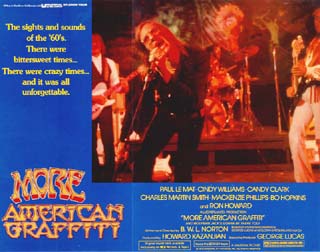
More American Graffiti features the late Doug Sahm.
More American Graffiti
D: Bill L. Norton (1979); with Cindy Williams, Ron Howard, Candy Clark, Paul Le Mat, Mackenzie Phillips, Charlie Martin Smith, Doug Sahm. Trying to re-create the magic of George Lucas'
American Graffiti was a risky venture for director Bill Norton and not altogether successful, mainly because the sequel employs split-screen imagery. It looked great onscreen in the theatre but loses so much when reduced to even a 27-inch television screen. It was also made six years after the original, so that even aging the characters appropriately diminishes some of the original's sweetness. With most of the major stars returning,
More American Graffiti does manage to retain some of its dignity and believably moves the story into the arena of political protest and cultural change. A montage of scenes at the beginning takes the viewer from balmy California to napalm-y Vietnam and sets the scene for social and personal rebellion. While
American Graffiti focuses largely on the male characters,
More American Graffiti recognizes the growing tide of feminism in America in two very different ways. Williams is Laurie Henderson Bolander, the former cheerleader who married her high school sweetheart (Howard) but yearns for a more meaningful existence than a house in the suburbs and two kids. Clark's character Debbie Dunham has already liberated herself physically from platinum bouffant to straight hippie hair, but inside she longs for a more traditional marriage. The split screen is distracting enough, but it is the choppy scenes representing the passage of time that make the story hard to follow.
More American Graffiti is not without its moments, though, and Cindy Williams' moment of realization -- when she defies authority to lead a police wagon full of women in singing "Baby Love"-- is a joy. (Texas viewers will enjoy seeing the late Doug Sahm in top form as the wacko singer of a band called Electric Haze.) Like its predecessor,
More American Graffiti ends thoughtfully, and to its credit does not wimp out on the original's somber reflection into the future.

